Apocynin improves oxygenation and increases eNOS in persistent pulmonary hypertension of the newborn
- PMID: 22198908
- PMCID: PMC3311530
- DOI: 10.1152/ajplung.00064.2011
Apocynin improves oxygenation and increases eNOS in persistent pulmonary hypertension of the newborn
Abstract
NADPH oxidase is a major source of superoxide anions in the pulmonary arteries (PA). We previously reported that intratracheal SOD improves oxygenation and restores endothelial nitric oxide (NO) synthase (eNOS) function in lambs with persistent pulmonary hypertension of the newborn (PPHN). In this study, we determined the effects of the NADPH oxidase inhibitor apocynin on oxygenation, reactive oxygen species (ROS) levels, and NO signaling in PPHN lambs. PPHN was induced in lambs by antenatal ligation of the ductus arteriosus 9 days prior to delivery. Lambs were treated with vehicle or apocynin (3 mg/kg intratracheally) at birth and then ventilated with 100% O(2) for 24 h. A significant improvement in oxygenation was observed in apocynin-treated lambs after 24 h of ventilation. Contractility of isolated fifth-generation PA to norepinephrine was attenuated in apocynin-treated lambs. PA constrictions to NO synthase (NOS) inhibition with N-nitro-l-arginine were blunted in PPHN lambs; apocynin restored contractility to N-nitro-l-arginine, suggesting increased NOS activity. Intratracheal apocynin also enhanced PA relaxations to the eNOS activator A-23187 and to the NO donor S-nitrosyl-N-acetyl-penicillamine. Apocynin decreased the interaction between NADPH oxidase subunits p22(phox) and p47(phox) and decreased the expression of Nox2 and p22(phox) in ventilated PPHN lungs. These findings were associated with decreased superoxide and 3-nitrotyrosine levels in the PA of apocynin-treated PPHN lambs. eNOS protein expression, endothelial NO levels, and tetrahydrobiopterin-to-dihydrobiopterin ratios were significantly increased in PA from apocynin-treated lambs, although cGMP levels did not significantly increase and phosphodiesterase-5 activity did not significantly decrease. NADPH oxidase inhibition with apocynin may improve oxygenation, in part, by attenuating ROS-mediated vasoconstriction and by increasing NOS activity.
Figures

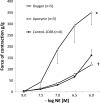
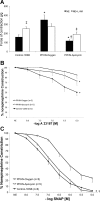

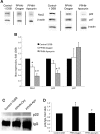

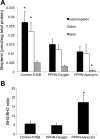
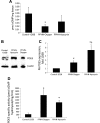
Similar articles
-
Betamethasone attenuates oxidant stress in endothelial cells from fetal lambs with persistent pulmonary hypertension.Pediatr Res. 2008 Jan;63(1):67-72. doi: 10.1203/PDR.0b013e31815b43ee. Pediatr Res. 2008. PMID: 18043518
-
Oxidant stress from uncoupled nitric oxide synthase impairs vasodilation in fetal lambs with persistent pulmonary hypertension.Am J Physiol Heart Circ Physiol. 2007 Apr;292(4):H1812-20. doi: 10.1152/ajpheart.00425.2006. Epub 2006 Dec 1. Am J Physiol Heart Circ Physiol. 2007. PMID: 17142346
-
Increased oxidative stress in lambs with increased pulmonary blood flow and pulmonary hypertension: role of NADPH oxidase and endothelial NO synthase.Am J Physiol Lung Cell Mol Physiol. 2006 Jun;290(6):L1069-77. doi: 10.1152/ajplung.00408.2005. Am J Physiol Lung Cell Mol Physiol. 2006. PMID: 16684951
-
Pathogenetic role of eNOS uncoupling in cardiopulmonary disorders.Free Radic Biol Med. 2011 Apr 1;50(7):765-76. doi: 10.1016/j.freeradbiomed.2010.12.018. Epub 2010 Dec 21. Free Radic Biol Med. 2011. PMID: 21172428 Review.
-
Therapeutics targeting of dysregulated redox equilibrium and endothelial dysfunction.Handb Exp Pharmacol. 2013;218:315-49. doi: 10.1007/978-3-642-38664-0_13. Handb Exp Pharmacol. 2013. PMID: 24092346 Review.
Cited by
-
Cyclic stretch stimulates mitochondrial reactive oxygen species and Nox4 signaling in pulmonary artery smooth muscle cells.Am J Physiol Lung Cell Mol Physiol. 2015 Jul 15;309(2):L196-203. doi: 10.1152/ajplung.00097.2014. Epub 2015 May 29. Am J Physiol Lung Cell Mol Physiol. 2015. PMID: 26024892 Free PMC article.
-
The Association between NADPH Oxidase 2 (NOX2) and Drug Resistance in Cancer.Curr Cancer Drug Targets. 2024;24(12):1195-1212. doi: 10.2174/0115680096277328240110062433. Curr Cancer Drug Targets. 2024. PMID: 38362697 Review.
-
Pulmonary hypertension and oxidative stress: Where is the link?Semin Fetal Neonatal Med. 2022 Aug;27(4):101347. doi: 10.1016/j.siny.2022.101347. Epub 2022 Apr 19. Semin Fetal Neonatal Med. 2022. PMID: 35473693 Free PMC article. Review.
-
Antenatal hypoxia and pulmonary vascular function and remodeling.Curr Vasc Pharmacol. 2013 Sep;11(5):616-40. doi: 10.2174/1570161111311050006. Curr Vasc Pharmacol. 2013. PMID: 24063380 Free PMC article. Review.
-
NADPH oxidase: its potential role in promotion of pulmonary arterial hypertension.Naunyn Schmiedebergs Arch Pharmacol. 2017 Apr;390(4):331-338. doi: 10.1007/s00210-017-1359-2. Epub 2017 Feb 11. Naunyn Schmiedebergs Arch Pharmacol. 2017. PMID: 28190244 Review.
References
-
- Alp NJ, Channon KM. Regulation of endothelial nitric oxide synthase by tetrahydrobiopterin in vascular disease. Arterioscler Thromb Vasc Biol 24: 413–420, 2004 - PubMed
-
- Anrather J, Racchumi G, Iadecola C. NF-κB regulates phagocytic NADPH oxidase by inducing the expression of gp91phox. J Biol Chem 281: 5657–5667, 2006 - PubMed
-
- Baumer AT, Kruger CA, Falkenberg J, Freyhaus HT, Rosen R, Fink K, Rosenkranz S. The NAD(P)H oxidase inhibitor apocynin improves endothelial NO/superoxide balance and lowers effectively blood pressure in spontaneously hypertensive rats: comparison to calcium channel blockade. Clin Exp Hypertens 29: 287–299, 2007 - PubMed
-
- Belik J, Pan J, Jankov R, Tanswell A. Peroxynitrite inhibits relaxation and induces pulmonary artery muscle contraction in the newborn rat. Free Radic Biol Med 37: 1384–1392, 2004 - PubMed
-
- Bradford MM. A rapid and sensitive method for the quantitation of microgram quantities of protein utilizing the principle of protein-dye binding. Anal Biochem 72: 248–254, 1976 - PubMed
Publication types
MeSH terms
Substances
Grants and funding
LinkOut - more resources
Full Text Sources
Medical
Miscellaneous

